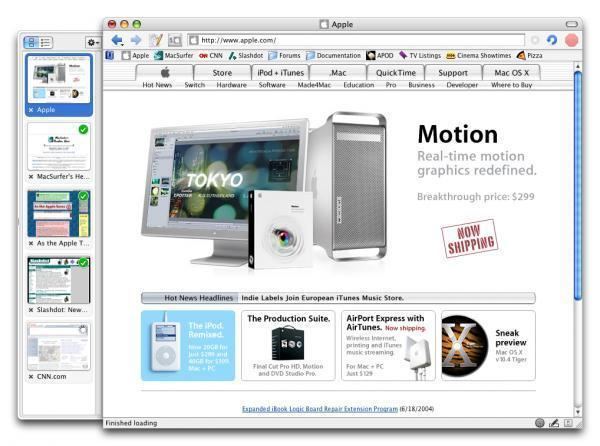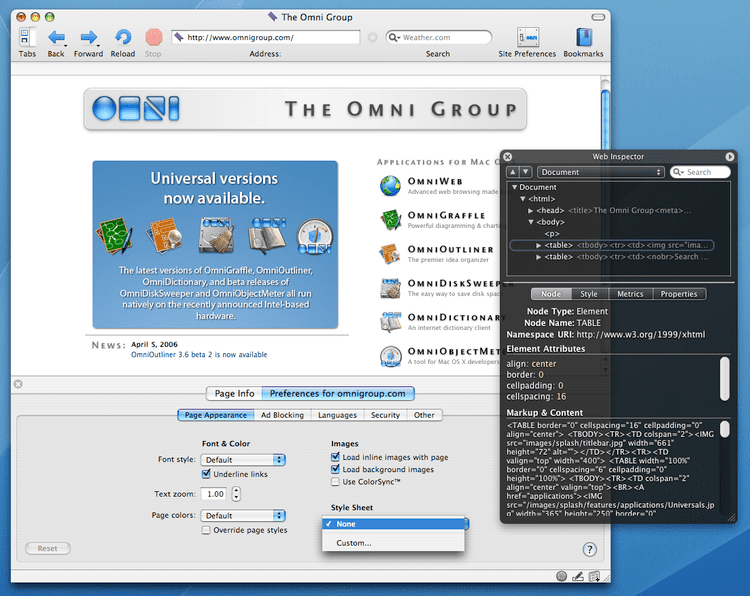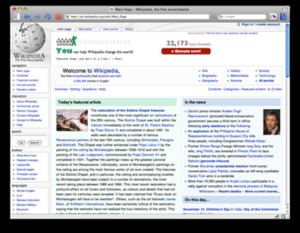Stable release 5.11.2 Downloadable Yes | Website omnigroup.com/ Initial release date 17 March 1995 | |
 | ||
Preview release 6.0-r279022 (February 10, 2017; 41 days ago (2017-02-10)) [±] Available in English, Finnish, French, German, Italian, Japanese, Simplified Chinese, Swedish, License | ||
Omniweb browser
OmniWeb is a proprietary Internet web browser developed and marketed by The Omni Group, currently developed exclusively for Apple Inc.'s Mac OS X operating system. It is available as a free download.
Contents

Omniweb 5 review
History

OmniWeb was originally developed by Omni Group for the NeXTSTEP platform, and was released by Lighthouse Design on 17 March 1995 after only one month's development time. As NextStep evolved into OpenStep and then Mac OS X, OmniWeb was updated to run on these platforms. OmniWeb also was able to run on Microsoft Windows through the Yellow Box or the OpenStep frameworks. After Lighthouse Design was bought by Sun Microsystems, the Omni Group released the product themselves, from version 2.5 onwards. From version 4.0 onwards, OmniWeb has been developed solely for the OS X platform.

OmniWeb is developed using the Cocoa API which allows it to take full advantage of OS X features. It uses Quartz to render images and smooth text. it will use multiple processors if available, and features an interface that makes use of Aqua UI features such as drawers, sheets and customizable toolbars.

OmniWeb originally employed its own proprietary HTML layout engine that used standard API NSText components. However, this engine was very slow, particularly when scrolling, and was not fully compatible with the most recent web standards, such as Cascading Style Sheets. In OmniWeb version 4.5, the Omni Group adopted Apple's KHTML-based WebCore rendering engine, which was created by Apple for its Safari browser.
On August 11, 2004, the Omni Group released version 5.0 of OmniWeb which included a number of new features. The most notable feature was an unusual implementation of tabbed browsing, in which the tabs were displayed vertically in a drawer on the side of the window (including optional thumbnail pictures of the pages.) Despite a certain amount of controversy over the merits of a tab drawer over a tab toolbar, the feature has persisted through the current version.
On September 6, 2006, version 5.5 was released. Major new features include the use of a custom version of WebKit instead of WebCore, universal binary support, saving to web archive, support for user defined style sheets, a "Select Next Link" feature, FTP folder display, ad-blocking improvements, updated localizations, many other small changes and bug fixes.
OmniWeb was Omni Group's flagship app but as OS X web browsers improved—Apple eventually bundled Safari— and Omni successfully introduced other products such as OmniGraffle and OmniOutliner, OmniWeb's importance diminished. OmniWeb's price was successively lowered, first to $39.95, then on February 24, 2009, Omni Group announced that OmniWeb would be made available for free, a change from its previous price of $14.95. Despite assurances from Omni Group that the browser is still under development, there has not been a final release since 2012.
Features
Reception
OmniWeb was most popular in the early 2000s when the OmniGroup's experience developing for OPENSTEP (which became the foundation for Mac OS X) gave them an edge over other developers. Until Apple's Safari, OmniWeb had the best support for Mac OS X technologies among its competition (chiefly Mozila Firefox and Microsoft Internet Explorer for Macintosh). John Siracusa, a technology journalist and critic for Ars Technica, said, "Finding [this level of functionality] in a proper Mac OS X application from a respected developer with a proven track record is like finding a perfect 1/10,000th scale replica of the Eiffel Tower in a box of crackerjacks. Then the tower transforms into a tiny robot and makes you lunch." [1]
